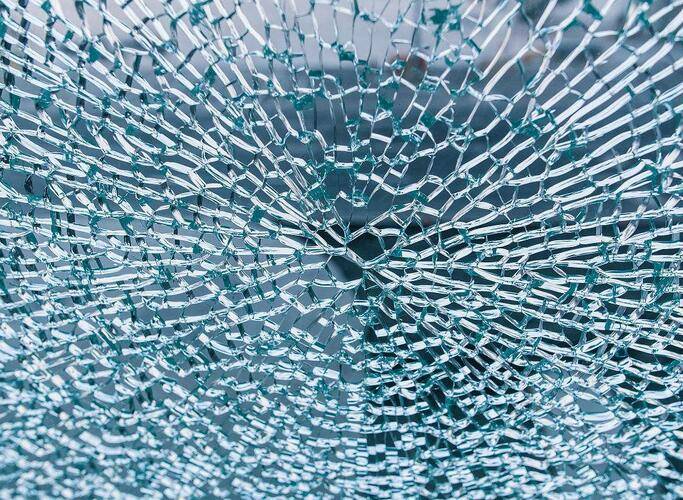Normal tempered glass has a spontaneous breakage rate of around three in a thousand. With improvements in the quality of the glass substrate, this rate tends to decrease. In general, "spontaneous breakage" refers to the glass breaking without external force, often resulting in glass shards falling from elevated heights, posing a significant danger.
Factors Affecting Spontaneous Breakage in Tempered Glass
Spontaneous breakage in tempered glass can be attributed to external and internal factors.
External Factors Leading to Glass Breakage:
1.Edges and Surface Conditions: Scratches, surface corrosion, cracks, or burst edges on the glass surface can induce stress that may lead to spontaneous breakage.
2.Gaps with Frames: Small gaps or direct contact between glass and frames, especially during intense sunlight, where different expansion coefficients of glass and metal can create stress, causing glass corners to be compressed or generating temporary thermal stress, leading to glass breakage. Therefore, meticulous installation, including proper rubber sealing and horizontal glass placement, is crucial.
3.Drilling or Beveling: Tempered glass that undergoes drilling or beveling is more prone to spontaneous breakage. Quality tempered glass undergoes edge polishing to mitigate this risk.
4.Wind Pressure: In areas prone to strong winds or in tall buildings, inadequate design to withstand wind pressure can lead to spontaneous breakage during storms.
Internal Factors Contributing to Glass Breakage:
1.Visible Defects: Stones, impurities, or bubbles within the glass can cause uneven stress distribution, leading to spontaneous breakage.
2.Glass Invisible Structural Defects: Excessive impurities of nickel sulfide (NIS) can also cause tempered glass to self-destruct because the presence of nickel sulfide impurities can lead to an increase in internal stress in the glass, triggering spontaneous breakage. Nickel sulfide exists in two crystalline phases (high-temperature phase α-NiS, low-temperature phase β-NiS).
In the tempering furnace, at temperatures much higher than the phase transition temperature (379°C), all nickel sulfide transforms into the high-temperature phase α-NiS. The glass rapidly cools down from the high temperature, and α-NiS does not have time to transform into β-NiS, freezing in the tempered glass. When tempered glass is installed in a customer's home, it is already at room temperature, and α-NiS tends to gradually transform into β-NiS, causing a 2.38% volume expansion.
After glass undergoes tempering, the surface forms compressive stress, while the interior exhibits tensile stress. These two forces are in balance, but the volume expansion caused by the phase transition of nickel sulfide during tempering creates significant tensile stress in the surrounding areas.
If this nickel sulfide is in the middle of the glass, the combination of these two stresses can cause tempered glass to self-destruct.
If nickel sulfide is on the glass surface in the compressive stress region, tempered glass will not self-destruct, but the strength of tempered glass will decrease.
Generally, for tempered glass with a surface compressive stress of 100MPa, a nickel sulfide with a diameter greater than 0.06 will trigger self-destruction, and so on. Therefore, choosing a good raw glass manufacturer and glass fabrication process is crucial.
Preventive Solutions for Spontaneous Breakage in Tempered Glass
1.Choose a Reputable Glass Manufacturer: Glass formulas, forming processes, and tempering equipment can vary among float glass factories. Opt for a reliable manufacturer to reduce the risk of spontaneous breakage.
2.Manage Glass Size: Larger tempered glass pieces and thicker glass have higher rates of spontaneous breakage. Be mindful of these factors during glass selection.
3.Consider Semi-Tempered Glass: Semi-tempered glass, with reduced internal stress, can minimize the risk of spontaneous breakage.
4.Opt for Uniform Stress: Choose glass with even stress distribution and smooth surfaces, as uneven stress significantly increases the risk of spontaneous breakage.
5.Heat Soak Testing: Subject tempered glass to heat soak testing, where the glass is heated to accelerate the phase transition of NiS. This allows potential spontaneous breakage to occur in a controlled environment, reducing the risk after installation.
6.Select Low-NiS Glass: Choose ultra-clear glass, as it contains fewer impurities like NiS, lowering the risk of spontaneous breakage.
7.Apply Safety Film: Install an explosion-proof film on the outer surface of the glass to prevent glass shards from falling in case of spontaneous breakage. Thicker films, such as 12mil, are recommended for better protection.

